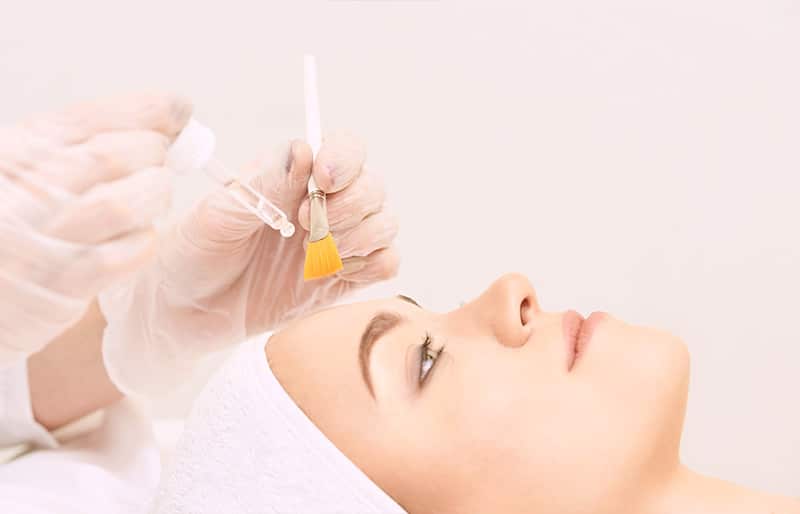Chemical peel uses a chemical solution to improve and smooth the texture of the facial skin by removing its damaged outer layers. It is helpful for those individuals with facial blemishes, wrinkles, and uneven skin pigmentation. Phenol, trichloroacetic acid (TCA), and alphahydroxy acids (AHAs) are used for this purpose. The precise formula used may be adjusted to meet each patient’s needs. Peels are a great way to maintain healthy skin and boost collagen production for a more youthful, vibrant appearance.

Chemical Peels and Other Skin Procedures
Chemical peels are more commonly performed for cosmetic reasons to improve facial wrinkles, hyper-pigmentation, and boost collagen production for a more youthful appearance. Chemical peels are also performed to remove pre-cancerous skin growths, soften acne facial scars and even control acne. There are basically three types of chemical peels, light, medium, and deep each increasingly aggressive and require more downtime.
Chemical peels are normally a safe procedure when performed by a qualified, experienced facial plastic & reconstructive surgeon. However, pre & post skin resurfacing treatment is vital for pigment control and optimal results.
Consultation with one of Premier’s Board Certified Facial Plastic Surgeons is necessary to determine the specific peel needed and pre & post operative skin care for optimal results.
Planning for Chemical Peels
It is very important that you find a physician who is board certified in facial plastic & reconstructive surgery and has experience in skin resurfacing. Your plastic surgeon may offer you a choice of peel techniques or suggest a different resurfacing procedure to obtain the best result for you.
During your initial consultation, it is important that you discuss your expectations. Ask any questions or express any concerns that you may have at this time. Your plastic surgeon will explain the planned procedure in detail, including its risks and benefits, the chemical peel recovery period and how to maintain beautiful, long-lasting results. Pre & Post Skin Resurfacing Treatment is paramount with all chemical peels.
Pre-peel treatment will be prescribed by your facial plastic surgeon and is often a combination of Retin A (a prescription medication derived from Vitamin A), hydroquinone, cortisone, and sunblock, are used to pre-treat the skin. Retin A thins out the skin’s surface layer allowing the TCA solution to penetrate more deeply. Hydroquinone is used to control pigment changes and improve hyper-pigmentation. Cortisone is used to control irritation and sunblock to protect the skin during treatment. Pre-treatment should start at least 2 weeks prior to your skin resurfacing procedure.
Light Peel
Alphahydroxy acids (AHAs), such as glycolic, or fruit acids are the mildest of the peel formulas and produce light peels. These types of peels can provide smoother, brighter-looking skin for people who can’t spare the time to recover from a more aggressive phenol or TCA peel. AHA peels may be used to treat fine wrinkling, areas of dryness, uneven pigmentation and acne. Various concentrations of an AHA may be applied weekly or at longer intervals to obtain the best result. Your facial plastic surgeon will work with you and the licensed medical aesthetician as your treatment proceeds. An alphahydroxy acid, such as glycolic acid, should be included in your medical skin care products as part of your daily skin care program. AHA peels may cause stinging, redness, irritation and peeling. Sun protection is vital to maintaining healthy, beautiful skin.

After an AHA peel, you may experience some temporary flaking or scaling, redness, and dryness of the skin. A fresher and improved skin texture will result with continued AHA treatments. Remember, protecting your skin from the sun is also important following these mild acid peels. Ask your doctor to recommend a sunblock with 30 UVA and UVB protection and use it every day.
AHA Peels are used to smooth rough, dry skin and improve texture and pigmentation. There is typically no or little downtime; however, as you progress in treatments you may experience more dramatic peeling. Treatments are generally done in a series of six, scheduling one every 2 weeks to achieve desired results. Alternating the AHA Peel with a microdermabrasion can enhance and boost treatment results.
Light Peels:
- Aids in control of acne
- Can be mixed with a bleaching agent to correct pigment problems
- Can be used as TCA pre-treatment
- Safe for darker skin
- A series of peels will be needed
- Sunblock use is recommended
Our light peels currently include the glycolic peel, fruit enzyme peel, revival peel and are offered through our Med Spa.
Medium Peel
Medium Peels, such as the TCA peel and salicylic peel, penetrate the skin more deeply than the superficial peel. Medium peels may be used to treat fine wrinkling, skin smoothness and vitality, and superficial discoloration. A medium peel must be repeated every three to six months for optimal results. Your facial plastic surgeon will work with you and the licensed medical aesthetician as your treatment proceeds. Medium peels may cause stinging, redness, peeling, and flaking. Sun protection is vital to maintaining healthy, beautiful skin.

After a medium peel, your skin will initially appear red. Within a few days, your superficial layers of skin will turn dark, become stiff, and resemble leather. They will then begin to crack, flake, and peel. The flaking is usually complete in four to seven days, with no open wounds and no scabs. Once your old skin has sloughed off, your new skin will be bright and flushed. You may begin wearing makeup after this. Although you will physically be able to return to work immediately, many people choose to wait seven days. You should resume skin care within two weeks of your procedure, and your flushed appearance will fade slowly over several weeks. experience some temporary flaking or scaling, redness and dryness of the skin. Ask your doctor to recommend a sunblock with 30 UVA and UVB protection and use it every day.
Medium Peels are used to treat fine wrinkles and improve skin texture and pigmentation. Although you may return to work immediately, you will experience dramatic peeling and many choose to wait seven days. Treatments are generally scheduled every three to six months for optimal results. Alternating the Medium Peel with a micro peel can enhance and boost treatment results.
Medium Peels:
- Highly effective in promoting skin smoothness and vitality
- Improve superficial discoloration
- Eliminate fine wrinkles
- Improve color, freshness, texture, and skin tone
- A series of peels will be needed
- Sunblock use is recommended
Our medium peels currently include the TCA peel, Vitalize Peel, brightening peel and the salicylic peel, and are offered through our Med Spa.
Deep Peel
Deep Peels are intensive chemical treatments to remove the top layers of skin. They often contain strong acids that penetrate deeply into the skin, offering significant improvements, but require careful handling and longer recovery times.

Deep peels take the most time of all of the peels and are the most painful. You may be given an oral sedative and pain relievers, possibly in the form of a shot or IV injection. General anesthesia may also be used. One area at a time will be treated, with a 15 minute break before the next area is treated to avoid too much chemical from getting into your system.
After a deep peel, The skin remains extremely red for between three weeks to up to 2 months for some people. Skin re-growth takes between 10 to 14 days after a deep peel. Most people take about two weeks off from work. Complete healing of the skin may take several months. You may be given oral pain relievers to reduce pain after the peel. You may also be given a short course of antibiotic and antiviral medicines to prevent infection after the peel. Some people experience severe swelling, especially around the eye area. Proper care is extremely important after the peel to speed healing and prevent infection. You may have to return several times to the plastic surgeon’s office to have the wound checked and cleaned.
Deep peels are used to treat severe wrinkles, long-term sun damage, pronounced pigment changed, and lesions and growths on the skin. These peels are only done on the face, and not on darker skin types because of the risk of bleaching the skin. A single deep peel may eliminate wrinkles and tighten the skin. These results are often dramatic. In general, a person can only have one deep peel.
Deep Peels:
- Eliminate wrinkles, longer-term sun damage, pronounced pigment changes
- Treats lesions and growths on the skin
- Only done on the face
- Tightens the skin
- Only one peel is done
- Extremely invasive
Our deep peels currently include the VI Peels, and Obagi Blue Peel, and are offered through our Med Spa.
Patient Reviews
VI Peels
The VI Peel utilizes a synergistic blend of ingredients, including salicylic acid and trichloroacetic acid (TCA), to improve the tone, texture, and appearance of the skin. It penetrates the outer layers to exfoliate damaged cells and trigger the regeneration of healthy, new cells. VI Peels can treat various skin types and conditions safely and effectively. They are commonly used for concerns such as acne, acne scarring, melasma, uneven pigmentation, sun damage, and early signs of aging. The depth of penetration makes the VI Peel ideal for smoothing fine lines and wrinkles while revealing clearer, brighter skin.

The VI Peel procedure is designed to be quick and relatively comfortable. The peel is applied to the skin using a brush, and the active ingredients work to break down the top layer of skin. This process is usually painless, although some patients may experience a slight tingling sensation. During the application, the skin may feel warm, and a fan can be used to alleviate any discomfort. The peel is left on the skin for several hours and is then washed off at home using a gentle cleanser.
VI Peel treatments take approximately 30 minutes to perform. Most patients do not report significant discomfort during the procedure. Mild redness, dryness, and peeling are normal in the days following as the skin naturally sheds damaged cells to reveal the renewed layers beneath.
Following a VI Peel, it’s important to take care of your skin to ensure the best possible results. You may experience some redness and peeling, which is a normal part of the healing process. The peeling usually starts around the third day after the treatment and can last for several days. During this time, it’s crucial to keep the skin hydrated and protected from the sun.
After the peeling phase, your skin will start to reveal a smoother, more even complexion. You may notice a significant improvement in the appearance of fine lines, wrinkles, and hyperpigmentation. It’s recommended to wait at least 4 to 6 weeks between treatments to allow your skin to fully heal and regenerate. Regular treatments can help maintain your results and address any new skin concerns that may arise.
Most patients notice a significant improvement in their skin’s appearance after just one treatment. This includes a reduction in the visibility of fine lines and wrinkles, improved skin texture, and a more even skin tone. The treatment can also help to lighten areas of skin darkened by sun damage or conditions like melasma.
VI Peels offer a range of benefits for patients seeking to enhance their skin’s health and appearance. From treating specific skin conditions to general rejuvenation, VI Peels can provide a noticeable improvement in your skin’s tone and texture.
VI Peels:
- Reduces the appearance of acne scars
- Evens out skin tone
- Improves skin texture
- Reduces signs of aging
- Treats hyperpigmentation and sun damage
- Suitable for all skin types
Our VI Peels currently include the VI Peel Purify, VI Peel Precision Plus, and VI Peel Purify (with Precision Plus) offered through our Med Spa.